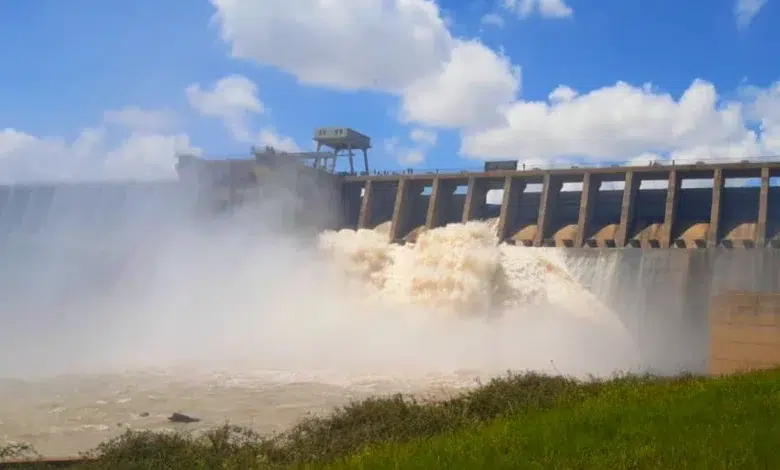Vaal Dam Tops 106% as South Africa Records Below-Normal Winter Rainfall

The Vaal Dam, a key water reservoir supplying Gauteng and neighbouring regions, has reached an impressive 106.14% capacity in early August 2025. This remarkable level indicates the dam is currently overflowing beyond its full supply capacity, despite South Africa experiencing below-normal winter rainfall overall. The dam’s status reflects heavy inflows from upstream catchment areas and ongoing managed water releases to balance water security and flood risk.

RELEVANT ARTICLE: Vaal Dam Maintains High Water Levels – Double the Volume from 2024
Table of contents
- What Is the Vaal Dam and Why Is It Important?
- Current Water Levels at the Vaal Dam
- Why Is the Dam Over Capacity?
- Managing Water Releases: Balancing Safety and Supply
- Impact of Below-Normal Winter Rainfall in South Africa
- Risks and Precautions for Communities
- How the Vaal Dam Supports Regional Water Security
- Coordination Between Dams in the Region
- Additional Notes on Other Significant Dams
- What Residents and Stakeholders Should Know
- Water Planning amid Climate Variability
- What This Means for Gauteng and Surrounding Regions
What Is the Vaal Dam and Why Is It Important?
The Vaal Dam is among South Africa’s largest reservoirs, holding about 2.5 billion cubic metres at full capacity. It plays a vital role in the Integrated Vaal River System (IVRS), supplying water to millions, including residents in Gauteng, Free State, and parts of North West province. Careful management of the dam’s water levels is essential for ensuring continuous supply and protecting downstream communities from flooding.
Current Water Levels at the Vaal Dam
As of the latest figures from 7 August 2025, the Vaal Dam stands at 106.14% capacity, slightly down from 106.5% reported the previous week. This indicates an overflow situation where the dam holds more water than its official full volume. The impressive water storage shows a significant improvement compared to the same period last year when the dam was only 48.1% full.
Why Is the Dam Over Capacity?
The South African Weather Service (SAWS) forecasts below-normal rainfall for much of the country’s winter season. However, the Vaal River catchment area has experienced heavier localized rainfall, leading to rapid inflows into the dam. The inflow rate stands at approximately 51 cubic metres per second, with outflow managed at about 16.8 cubic metres per second, according to water resource monitoring from The Reservoir.
The Vaal Dam, a key component of the Integrated Vaal River System (IVRS), continues to play a vital role in ensuring reliable water supply to Gauteng and the Free State. It is presently storing approximately 2.57 billion cubic metres of water, well above its designated full supply volume, underscoring the system’s resilience and ability to meet regional demand.
Heavy rainfall in the Vaal River catchment area has caused rapid inflows into the dam. To manage this, sluice gates have been opened progressively to release excess water downstream. The Department of Water and Sanitation (DWS) carefully controls these releases to minimise flooding risks while protecting infrastructure and communities.
Managing Water Releases: Balancing Safety and Supply
The DWS is monitoring the Vaal Dam’s outflows closely. Releases have been increased systematically through multiple sluice gates to maintain safe water levels and prevent uncontrolled flooding. The increased water volume flowing downstream raises the risk of riverbank overtopping and flooding, especially in low-lying areas such as the Vaal Triangle and Parys.
Impact of Below-Normal Winter Rainfall in South Africa
Despite the Vaal Dam’s high levels, South Africa’s central regions are experiencing normal to below-normal rainfall this winter season. The South African Weather Services (SAWS) forecasts that the dam’s current fullness is a result of localized heavy rains upstream rather than consistent rainfall across the country. This situation highlights the variability in rainfall patterns within South Africa.

Risks and Precautions for Communities
Residents and farmers located in flood-prone areas downstream of the dam are urged to be vigilant and prepared for potential flooding. Evacuations have been recommended in some vulnerable zones as a precaution. The Department continues to update the public through official channels about the evolving situation.
How the Vaal Dam Supports Regional Water Security
The Vaal Dam’s resilience and capacity to hold excess water help mitigate the effects of drought and fluctuating rainfall. Maintaining a high water level ahead of the summer season aims to secure a steady water supply during potentially dry months, protecting urban and agricultural needs.
Coordination Between Dams in the Region
The Bloemhof and Grootdraai Dams, also part of the Integrated Vaal River System, have similarly high water levels, with reported capacities exceeding 106%. Coordinated management of these dams is critical to control water flows and reduce downstream flood risks, underscoring the complexity of regional water infrastructure management.
Other dams in the IVRS are also near or above capacity:
- Bloemhof Dam: 109.2%
- Sterkfontein Dam: 99.3%
- Grootdraai Dam: 99.4%
This regional coordination is crucial to managing water flow safely and ensuring balanced water supply. Water from these dams flows downstream through the Vaal River system, necessitating careful release controls to prevent flooding, especially in flood-prone areas like the Vaal Triangle and Parys.
Additional Notes on Other Significant Dams
- Gariep Dam, South Africa’s largest reservoir, is at 99.5% capacity, an improvement from 78.2% in the previous year.
- Vanderkloof Dam holds 99.2%, fed by the Orange River: South Africa’s largest river system.
- Hartbeespoort Dam is reported at 100.5%, also contributing to regional water security.
These levels demonstrate strong water storage despite climatic variability, offering some relief in drought-sensitive zones.
What Residents and Stakeholders Should Know
- The high water level signals effective rainfall capture but also a need for cautious water release.
- Flood warnings remain in place; residents in low-lying areas should heed evacuation advice.
- Authorities recommend staying informed via Department of Water and Sanitation updates.
- Conservation and efficient water use remain important to balance supply and demand.
Water Planning amid Climate Variability
South Africa’s water authorities continue to navigate the challenges posed by irregular rainfall patterns and climate change. Strategic storage of water in major dams like Vaal helps buffer against dry spells. However, the variations in rainfall require adaptive management and preparedness to protect communities and maintain water reliability year-round.
Want to know when your taps might run dry and how to stay ahead of it? 10‑Hour Water Outages Scheduled for Parts of Johannesburg – Full Details and Preparation Tips. Click to get all the info and smart tips to prepare.
What This Means for Gauteng and Surrounding Regions
Gauteng relies heavily on the Vaal Dam and the IVRS for its water supply. High dam levels ahead of the dry summer months help secure water availability for households, industries, and agriculture. However, managing both overflow risks and preparing for drier spells highlights the complex balance faced by water authorities.




